Moso Natural Air Purifying Bag Review
Unpleasant odors - from cigarette smoke, cooking, pet litter, cleaning chemicals, and mold - are a social embarrassment and a health problem.The number one principle any indoor air authority will cite is "attack the source before installing the air cleaner."
But there are many odor sources that cannot easily be removed.
For several years, I have been advising people to "just put some carbon near the odor," without stumbling onto the products from Moso.
Moso Natural offers a natural odor control product, the Moso Air Purifying Bag.
Moso introduced their bags to the American market in August 2010, creating a new product category.
Despite the company's overstated "green" marketing and somewhat exaggerated claims, I like this product as an alternative to the popular, and often toxic, "air fresheners" and other chemical responses to the indoor odor problem.
Most of the billions spent on indoor odor devices, found in three quarters of American homes, goes to unhealthy scent-maskers that just fool the nose into thinking air is clean.
I join other indoor air quality experts, who universally recommend against using chemical air fresheners/deodorizers of any kind.
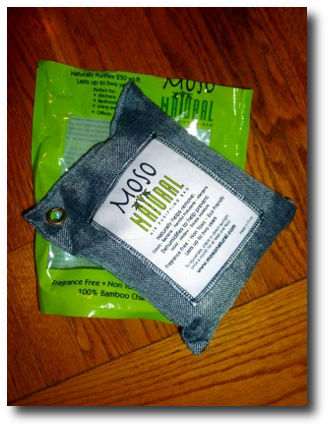
At least as bad are things that burn, such as scented candles, covering the odor with a new scent and filling the air with tiny black spheres of carbon.
With the largest Moso Natural bag (500 grams) selling for about twenty bucks, here is an option for folks who can't pony up for a motorized air cleaner, many of which have less carbon than the Moso bag.
Small Mosos, sized nicely for insertion into stinky boots or hanging on a cat litter box, are two for ten bucks.
Moso's bags are passive air purifiers, meaning they have no fan to propel air through the adsorbent media.
Many vendors and numerous user reviews use the term absorb to describe the process of odor molecule retention.
The correct term is "adsorb," which means molecules attaching to a surface by electrostatic (ionic) attraction.
"Passive" also means the bag requires little effort from the user, other than occasional airing out and sunning the bag.
Moso's market penetration includes The Container Store, and Amazon.com carries the "natural" bags.
I found almost 100 online user reviews of the Moso bags, with an average rating of four stars.
However, over 20% of these reviews are negative one and two star reviews.
Numerous buyers have expressed dissatisfaction.
Let's delve into the reasons why with a closer look at the marketing claims and actual capabilities of the Moso Natural Air Purifying Bags.
What's in the Moso Bag?
Many buyers have trouble visualizing the tiny size of odoriferous pollutants.
Gas molecules, "Volatile Organic Compounds" (VOC), are generally less than 0.001 micron in diameter, far smaller than the particles captured by HEPA filters.
Most air purifiers use some form of porous activated carbon as the adsorption medium.
A 200 gram Moso bag has approximately 50 acres of interior surface area.
The best way to visualize activated carbon is as a huge cave with thousands of small chambers.
VOC and odor molecules hang in these pockets like millions of bats in a cave.
But not all charcoal is created equal, and various pollutants are held more tightly than others.
There is a constant coming and going of bats, with some leaving and some coming back to roost.
As the filter ages and becomes saturated, the equilibrium of coming and going slowly shifts to favor more molecules escaping.
Polar molecules, those with unbalanced charges, are more difficult to retain.
Aldehydes, with their characteristic sweet odor, are among the most difficult to adsorb over time.
Charcoal is available in a wide range of grades and is made from several substrates, like cocoanut shells.
Moso bags use 100% bamboo charcoal from China.
They are non-toxic, and have no odor of their own.
I bought a 200 gram bag, and my hyper-sensitive nose (long time MCS) finds no offense from a new Moso Natural bag.
Does Moso Work as Claimed?
I am all in favor of the Moso concept, but have some reservations about marketing claims made by the company and some vendors.There is no question that Mosos really do work, when installed as described below.
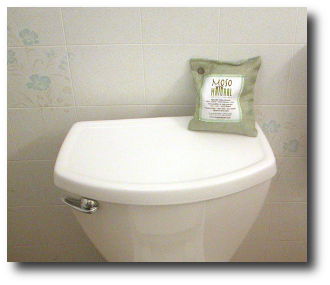
But I must take issue with marketing claims made for Moso Natural Bags and bamboo charcoal products in general.
First, there is no scientific way to test the effectiveness of a small passive chemical air purifier in residential settings, where thousands of possible combinations and intensities of VOCs and odors may exist.
For particulate air pollution, consumer grade laser particle counters are available that provide accurate measurements.
But with odors and chemicals, subjective smelling will continue to be the prime metric of user satisfaction.
The human sense of smell is dulled by millennia of civilized life, nutritional deficiencies (zinc...), and habituation to very foul air.
Individuals can have widely varying olfactory thresholds.
Each source has a different concentration and chemical composition, and every room has different ventilation.
So some Moso buyers will get odor relief and others will not.
"Airborne bacteria will be absorbed into the (Moso bag's) bamboo charcoal," is no doubt a true statement.
But the implication that any meaningful reduction in airborne microorganism densities can be achieved is, in my opinion, false.
I am also extremely skeptical about claims of allergen sequestration, and cannot find a single user testimonial to the effect that allergy symptoms are improved by the Moso Bag.
But one user review said their atopic dermatitis, and another review their asthma, both associated with airborne mold spores, improved after installing the bag.
Several user reviews are ambivalent or negative about results with allergies.
Then there are claims about humidity control and mold growth.
Numerous user reviews support the idea that bamboo charcoal buffers moisture, with one blog review observing steam clearing quickly off a mirror after a shower.
Using a carbon odor adsorber as a dehumidifier would not be my first choice, and the limits to this strategy should be obvious.
However, moisture is commonly associated with mold, and the dehumidifying effects are more likely to be the basis for mold reduction claims than direct interdiction.
I doubt that the passive bag, without forced airflow, can capture enough airborne mold to make much difference.
User reviews differ, generally by whether the reviewer is a smoker or a non-smoker, as to whether Moso Bags adsorb cigarette smoke.
Tobacco smoke is a complex hazard, with particulate of many sizes and thousands of toxic chemicals.
Trying to cover up indoor smoking with any passive device, or even an expensive electric air purifier, is sheer folly.
Even the strongest fan-forced air purifiers, those with 450 CADR ratings, will need to work at max power to make a serious reduction in the health hazards of smoking in the home.
I'm also a bit skeptical about the marketing suggestion to "Place Moso Bags in newly remodeled rooms to reduce the unpleasant and often toxic odors from new paint, carpeting and furniture."
While this may actually work if the room is closed and people and pets kept out while the bag slowly lowers VOC levels, using a passive device so as to reenter the room sooner may be a big mistake.
Several VOCs associated with paint and carpet remain hazardous even when the odor level falls below the olfactory threshold.
Other bamboo charcoal products (NOT Mosos) are sold with even more tenuous claims, like negative ion generation and EMF shielding.
Coverage
As with almost every air cleaning product. I recommend smaller room sizes than manufacturers will.Air circulation, source type, and emission continuity will cause variable results, especially when a passive device is chosen.
The Moso Bag is available in three sizes, with carbon measured in grams.
In the USA, air purifier carbon is generally expressed in pounds (for premium units with heavier carbon) or hidden behind jargon (less expensive purifiers with light carbon).
Carbon is frequently omitted from cheaper air cleaners, while serious machines contain from five to thirty pounds.
One pound contains about 454 Grams.
So Moso's smallest bag, the 50g Mini Moso Bag, contains maybe one ninth of a pound of adsorbent material.
The Moso 200 gram holds around one third pound, and the 500 gram bag has over one pound of premium carbon.
The smallest of the Mosos is advertised to "cover 10 square feet."
I recommend installing the small air purifying bag in close quarters, like inside shoes, backpacks, gym bags and lockers, rather than as an area air cleaner.
Moso's middle-sized bag, with 200 grams carbon, is advertised as appropriate for 90 square feet, about the size of a small bedroom.
Again, I think this room size is quite ambitious if the typical household odor scenario (cat box, kitchen frying/toasting, dry cleaned clothes in closet...) is anticipated.
I like Moso's 200 gram bag for auto interiors, small closets with doors closed, and other small enclosed areas.
The largest of the Moso Naturals is the 500 gram size, advertised as suitable for 250 square feet.
The vast majority of powered air cleaners I review are recommended for less than 250 square feet.
I think marketing-raised consumer expectations are a big factor in the high percentage of sour user reviews.
Buyers are expecting the inexpensive passive bag to work like a powered air purifier.
It doesn't.
Modest expectations, source removal or reduction, and long waits are required with any passive air purifier.
I recommend using the pound of carbon in the Moso 500 in rooms to 150 square feet, an average bedroom.
In larger spaces, I'd place the bag very close to the source, and not expect dramatic results over the whole area.
Recommended Applications for the Mosos
With those limits in mind, there are many spots in every home where an electric air purifier cannot be placed.
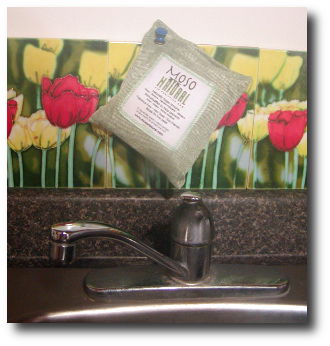 |
Short cords and scarce electric sockets may put an odor source area off limits to plug-in air cleaners.
Moso bags are compact, unobtrusive, and have a grommet for hanging almost anywhere.
This allows Mosos to hang directly over cat litter boxes, but the bag is NOT a substitute for cleaning out the litter box on a regular basis.
Several user reviews mention putting the Moso bag inside another bag with a smoke or scent-contaminated item, like a purse or jacket.
Some user reviews say the Mosos work well in closets, hung on a clothes hanger.
Mosso bags are reported to work well when placed inside a garment hang bag.
New parents are the target of much misleading marketing.
Most onerous to me is the notion that diaper changing areas and nurseries are good places for toxin-emitting air fresheners.
Moso's best marketing claim, in my opinion, is that it does no harm.
Unlike some competitors (Citrus Magic, Bad Air Sponge...), the Mosos are non-toxic and fragrance-free.
This makes it perfect for the inevitable nursery odor situation.
Doggy beds and baskets are another ideal application.
Athletic gear is another great carbon bag target.
Inside the refrigerator is an ideal spot, where the Moso can replace harmful ozone oxidizers.
We put food in the fridge to slow oxidation, who'd put a powerful oxidizer in there with it?
Kitchen garbage cans and cooking areas can have a Moso Natural hung nearby.
New furniture can have Moso bags as "throw pillows."
Moso originally developed the bags for automotive applications.
Car interiors are notoriously smelly, from the new car smell to somebody else's perfume.
Sales of mirror-hung toxic air fresheners are brisk.
User reviews report success with mild automotive odors, but a trunk full of spilled gasoline is asking too much from the bag.
Recycling the Moso Charcoal?
Moso bags are said to last "for up to two years" before needing replacement.This will vary with the type of pollutant and intensity of emission.
If users smell the desorbtion of gasses, the bag may be near saturation.
Moso says the bag can be rejuvenated by placing it outdoors in direct sunlight.
While this may work in mild circumstances, seriously saturated activated carbon is very difficult to recycle.
"Gives Back to the Earth"
I don't agree with the notion that saturated activated carbon is safe to dispose of casually.Marketing literature targets the "green" by suggesting that used Moso bags can be cut open and the contents used around the home and garden.
I cannot recommend this practice.
The bag is said to adsorb "formaldehyde, ammonia, benzene, and chloroform gases."
Most of this noxious stuff is still in the bag.
Although I endorse and use the Moso Bag, users are advised to "give back to the earth" by disposing of the contaminated bags in the nearest landfill.
The bags, once used, are not returnable.
Air Purifier Applications for the Moso Bags
Moso Natural is a startup (2009) out of Oakhurst, New Jersey.I think Moso has overlooked a large possible market, replacement filters for electric air cleaners.
Here is a perfect application for the bamboo carbon bag.
I put the 200 gram Moso bag in my Winix 5300, substituted it for a pricey Sharp Plasmacluster carbon bag, dropped it into the center of my 14-inch round Honeywell 50250, and even tried it in my $900 IQAir HealthPro.
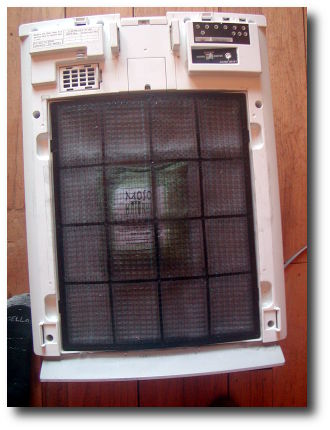 |
For air cleaners without enough space inside the filter bay, just hang the Moso where it will intercept the air purifier's exhaust airflow.
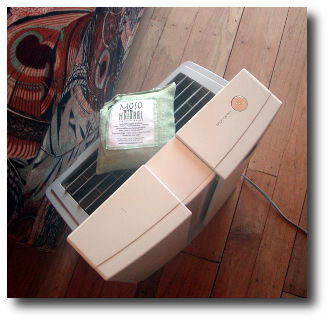 |
With air purifier odor filters being among the industry's highest margin items, the ten to twenty bucks for a Moso looks like a bargain.
I pay about seven dollars a pound for air purifier carbon, and the labor to sew a bag quickly adds up, so the 500 gram/one pound Moso Natural bag looks very fairly priced at $20.
Conclusions
Pros
flexible, can mount anywhereadsorbs toxins and odors, instead of masking
cost effective when used correctly
much safer than chemicals used to mask odors
relatively inexpensive when used in light odor situations
Cons
NOT a room air purifier!most effective in confined spaces
some unrealistic advertising claims
exaggerated green image
I think the Moso Natural Bag is a wonderful alternative to toxic mainstream odor control methods.
But buyers should have reasonable expectations, installing the larger Mosos in small confined spaces, and the 50 gram bag in shoes, backpacks, and hand bags.
You can find the Moso Bags at Amazon:
Moso Natural Air Purifying Bag, 500gm
Moso Mini Natural Air Purifying Bag
Site Navigation
End Moso Natural Air Purifying Bag Review, goto Homepage: Air Purifier Reviews
